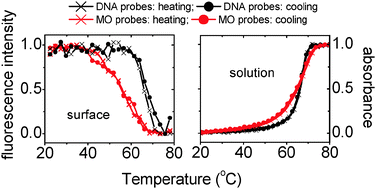Surface vs. solution hybridization: effects of salt, temperature, and probe type†
Abstract
Hybridization thermodynamics on solid supports are compared with those in solution for two types of hybridization probe, DNA and uncharged morpholino oligonucleotides of identical sequences. Trends in hybridization affinity are discussed with respect to ionic strength, temperature, and surface behavior.


 Please wait while we load your content...
Please wait while we load your content...